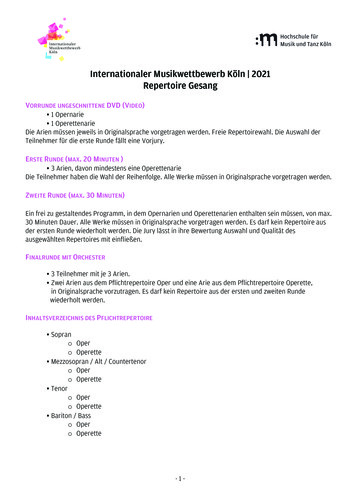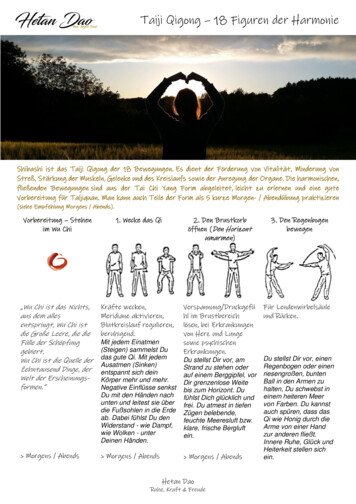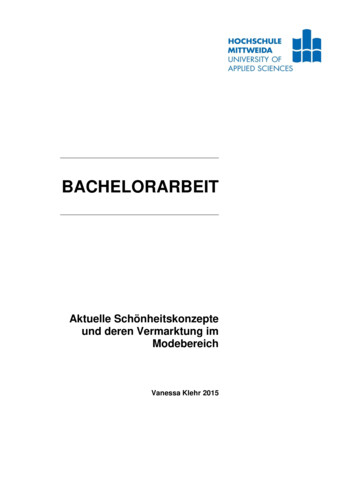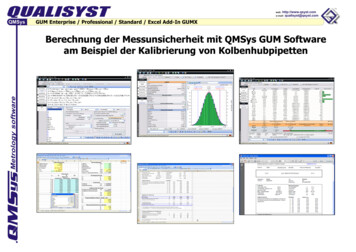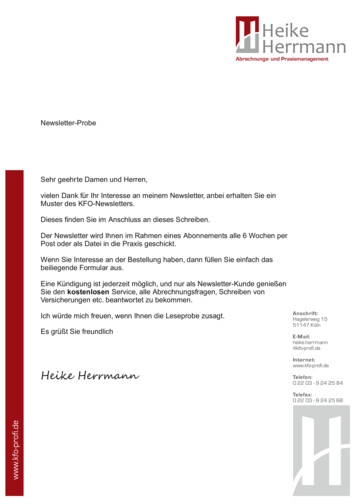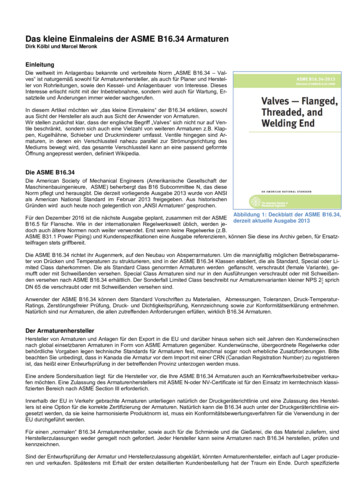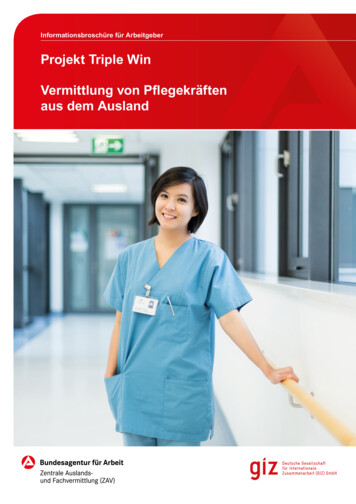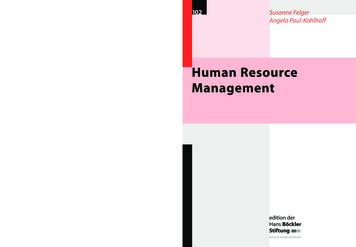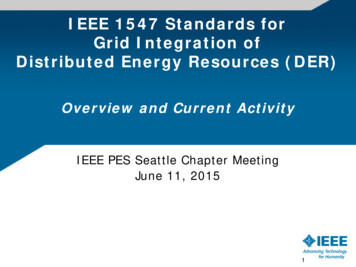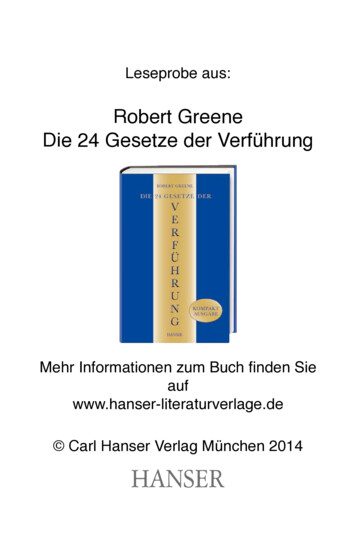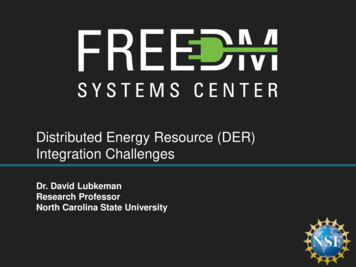
Transcription
Distributed Energy Resource (DER)Integration ChallengesDr. David LubkemanResearch ProfessorNorth Carolina State University1
Where Were You in 2008?NSF Launches an Engineering Research Center for the Creation of a Green Energy GridThe National Science Foundation (NSF) announces an award to North Carolina State University and itspartners to establish a new NSF Engineering Research Center (ERC). The ERC will developinterdisciplinary research and education programs that address an important energy issue and providethe foundation for new industries through innovation. NSF will invest approximately 18.5 million inthe Center over the next five years.The NSF ERC for Future Renewable Electric Energy Delivery and Management (FREEDM) Systems willconduct research to transform the nation's power grid into an efficient network that integratesalternative energy generation and novel storage methods with existing power sources. This new,distributed network would permit any combination and scale of energy sources and storage devicesthrough standard interface modules. The Center's overall goal is to facilitate the use of green energysources, reduce the environmental impact of carbon emissions, and alleviate the growing energycrisis.NSF FREEDMPress Release –Sept 8, 2008https://www.nsf.gov/news/news summ.jsp?cntn id 1121792
Primary Energy Production by Sourcerenewables3
Number of PV Systems x4
Installed Price of PV From Tracking the Sun IX – LBNL report In 2007, Residential PV around 9/Watt In 2015, Residential PV down to 4/Watt5
Presentation ObjectiveLay groundwork for following FREEDM webinars onFREEDM technology by discussing: Overview of traditional distribution circuitoperation Circuit voltage regulation Distributed Generation integration issues, withfocus on photovoltaic energy Sample Circuit analysis results Traditional vs. FREEDM approach6
Electric Power SystemSource: Wikipedia – Electric power distribution7
Transmission and DistributionVoltage LevelsGeneration18-24 kVTransmission138-765 kV 0 kVDistributionSubstationIndustrialCustomer4160 VVoltageRegulatorCommercialCustomer208 VDistributionTransformerResidentialCustomer120/240 (SinglePhase)PrimaryFeeder,2.5-34.5 kVBulk TransmissionSubtransmissionDistribution SubstationPrimary FeederDistributionTransformer– Secondaries andServices–––––SecondaryFeederServices8
Distribution Substation Connects to atransmission grid Transmission toDistribution PrimaryVoltage Conversion Voltage Control Feeder Protection Switching9
Distribution Feeder LayoutTapped Laterals Substations connect totransmission orsubtransmission. Each Feeder serves an area. Main Feeder typically followsmain roads. Laterals connect to individualbusinesses or households. Laterals can be on streets butcan cut through other accesspaths (alleys).Three-Phase Main FeederSubstation10
Primary Overhead Feeder Connects substationtransformer tocustomer distributiontransformers Backbone is threephase with single ortwo-phase taps11
Overhead Distribution Transformer& Service Converts primaryvoltage tosecondary level Secondary serviceconnects tocustomer meter Note: customervoltage related toprimary voltageby turns ratio ofthe transformer12
Padmount Distribution Transformer Mounted inenclosure onconcrete pad Primary andsecondarybothunderground13
ANSI Voltage Delivery Standards
Typical Voltage Profile Substation LTC or busregulator controlsvoltage at top ofcircuit.Limit voltage at topof feeder to 127 V,assuming secondaryhas 1 V drop.Slope of curvechanges as loadincreases ordecreases.Utilities typicallywant voltage to stayabove 117-118 V.15
Approximate Voltage DropRelationship16
Notes about this Voltage DropRelationship Resistive Load – for high power factor, voltage drop highlycorrelated to the resistance of the conductors. Reactive Load – for lower power factor, voltage drop highlycorrelated to reactance of conductors. Reactive power injection (negative VARs) due to capacitors willboost voltage. Real power injection (negative load) due to distributedgeneration will boost voltage.17
Primary Distribution VoltageControlsOptions for Regulating Voltage on aFeeder:Substation load tap-changingtransformersSubstation feeder or bus voltageregulatorsLine voltage regulatorsFixed and switched capacitors18
Line Voltage Regulator Banks Regulate voltage at pointsdownstream fromsubstation. Essentially anautotransformer withmany taps in the serieswinding. Common distributionregulator: /- 10%, 32 taps ⅝ % (.75 volts on 120volt base) per tap Feedback control keepsload side voltage withinproper range.19
Voltage Regulator Impact20
Line Capacitors Fixed or SwitchedCapacitor Banks Benefits: Power Factor Improvement Voltage Improvement Loss Reduction21
Capacitor Impact on Voltage Profile22
Distributed Energy Resource (DER) A device that produces electricity, and is connected to theelectrical system, either "behind the meter" in the customer'spremise, or on the utility's primary distribution system. A Distributed Energy Resource (DER) can utilize a variety ofenergy inputs including:– Natural Gas– Biofuel– Solar– Wind– Batteries In this presentation, will focus on impact of Photovoltaic(solar) Systems.23
PV System - Residential Residential ScaleSystems. Typically 5 kW forhouses, but that istrending up. String-Inverter vs.Micro-InverterTechnology.24
Residential Interconnection Excess powerbackfeeds into theutility distributionsystem. Utility has no directcontrol of inverter oncustomer side ofmeter. Injected power canbe variable. PV generation canimpact othercustomers connectedto distribution grid.25
Basic Issue: Changes in RadialFeeder Power Flows DER invalidates historical assumption of unidirectional powerflow, which will perturb typical distribution system operations. System typically optimized for decreasing load density, withwire sizes dropping as we go further from the substation. System voltage regulation originally designed for voltage dropfurther from substation. Impact varies as we go from a few 5 kW residential systems toone or more 5 MW systems.26
Distribution-Level PV ConcernsMW-Scale PV closeto substationSubstationPrimaryFeedersMW-Scale PV farfrom sVoltageRegulatorSwitchedCapacitorPV10 kW – 100kW Scale PVatCommercialLoadPVPadmountTransformerSunny Day Ability to properlyControl Voltage duringReverse Power FlowMany 2-3 kWScale PV atResidentialLoadAlternateBackfeedSource Additional Wear onVoltage Control Devices Voltage Flicker atCustomer Loads Coordination ofProtection Relays Constraints on RecloserOperationPVImpact of Cloud Cover27
High Voltage due to DER Reverse power flow will cause voltage rise (negative voltage drop). Under light load conditions when primary voltage is high, voltagerise can push voltage over ANSI voltage limits.28
Voltage Rise on Secondary Circuit Even small amounts of DER can impact voltage, if there is injected power flowunder light load conditions. Distribution models typically do not include customer transformer andsecondary, so need to make sure additional secondary voltage rise is not an issue.29
Interaction with Voltage RegulatingEquipment If DER has time-varyingoutput, will change systemcurrent flow enough tocause a regulator tapchange or operation of aswitched capacitor bank.Also DER with voltagecontrol may not work wellwith utility regulationequipment.This leads to undesirablecycling of voltage regulatorsand voltage power qualitydegradation.30
Voltage Flicker Intermittent DERoutput is reflected inboth load current andload voltage. Rapid fluctuations involtage referred to asVoltage Flicker. Can measure this witha Flicker Meter (IECStandard).Cloudy Day Profile31
Voltage Fluctuations and LightFlicker Light flicker created by fast changing loads and generation thatcause fluctuation in the voltage. Amount of irritation depends on both the frequency and magnitudeof these fluctuations, characterized by a flicker curve.32
Sample Circuit Study Circuit Characteristic– System Voltage: 12.47 kV– Peak Load (year): 6.7 MW– Feeder Length: 3 miles Baseline Simulation ResultsTop of the Feeder6.8 MWHigh Customer Voltage124.1 VLow Customer Voltage117.3 VLosses170 kW33
Peak Loading With PV PV Systems– Size: 100% of the load peak– Number of PV: 299– 6.7 MW in total Simulation ResultsTop of the Feeder0.07 MWHigh Customer Voltage124.5 VLow Customer Voltage122.8 VLosses68 kWLoads are compensated by PV.Dramatically drop in losses.Voltage rises to 122-124 V range.34
Light Loading Light Loading Condition– 40% of the Peak Load– Load: 2.8 MW Simulation ResultsTop of the Feeder2.8 MWHigh Customer Voltage124.3 VLow Customer Voltage121.5 VLosses76 kW35
Light Loading With PV Light Loading Condition– Load: 2.8 MW– PV: 6.7 MW Simulation ResultsTop of the Feeder-3.9 MWHigh Customer Voltage126.7 VLow Customer Voltage123.9 VLosses97 kWPV is back feeding into the grid.A little bit increase in losses.Overvoltage issues!36
Possible Mitigation Options withToday’s TechnologyDistribution Circuit Upgrades ( - Expensive to overbuild circuit) Reconductor to lower voltage drop and increase ampacity Relocate/Add line voltage regulators and capacitor banksFeeder Device Controls ( - Limit to simple changes that can be made) Modify reference voltages, line drop compensation, bandwidth anddelaysDER Inverter Control ( - Stability issues for high penetration levels) Operate leading power factor to help control voltage Deploy active reactive power control (smart inverter)Battery Energy Storage System compensation ( - Too Expensive forpower management only)Today’s technology won’t get us to the very high-penetrationscenarios being proposed for future grid systems.37
Where does the FREEDM Center come in?We need new enabling technology for high-penetrations of DER.Vision is to build an internet for energy: a network of distributed energyresources that intelligently manages power using secure communicationsand advanced power electronics.Research priorities: Power electronics packaging Solid state transformers Fault isolation devices Controls theory Power systems simulation and demonstrationMany other technologies will play a supporting role including batterystorage, smart thermostats, real-time use monitors and apps.38
FREEDM System ConceptFID Fault Interruption DeviceSST Solid State TransformerDRER Distributed Renewable Energy DeviceDESD Distributed Energy Storage DeviceCapable of operation withenergy from the gridsupply, or in islanded modeusing only stored energyand distributed resources.39
Transformer Secondary Feeder Services. Distribution Substation Connects to a transmission grid Transmission to Distribution Primary . Power systems simulation and demonstration Many other technologies will play a supporting role including battery storage,
